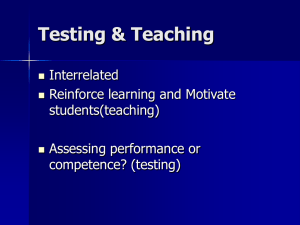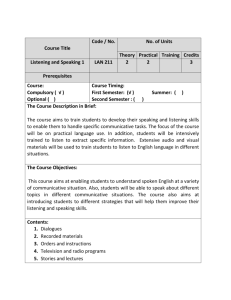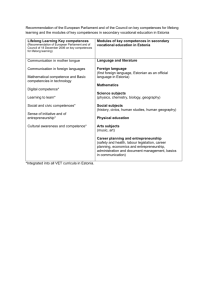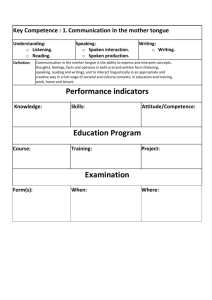COMMUNICATIVE COMPETENCES
advertisement
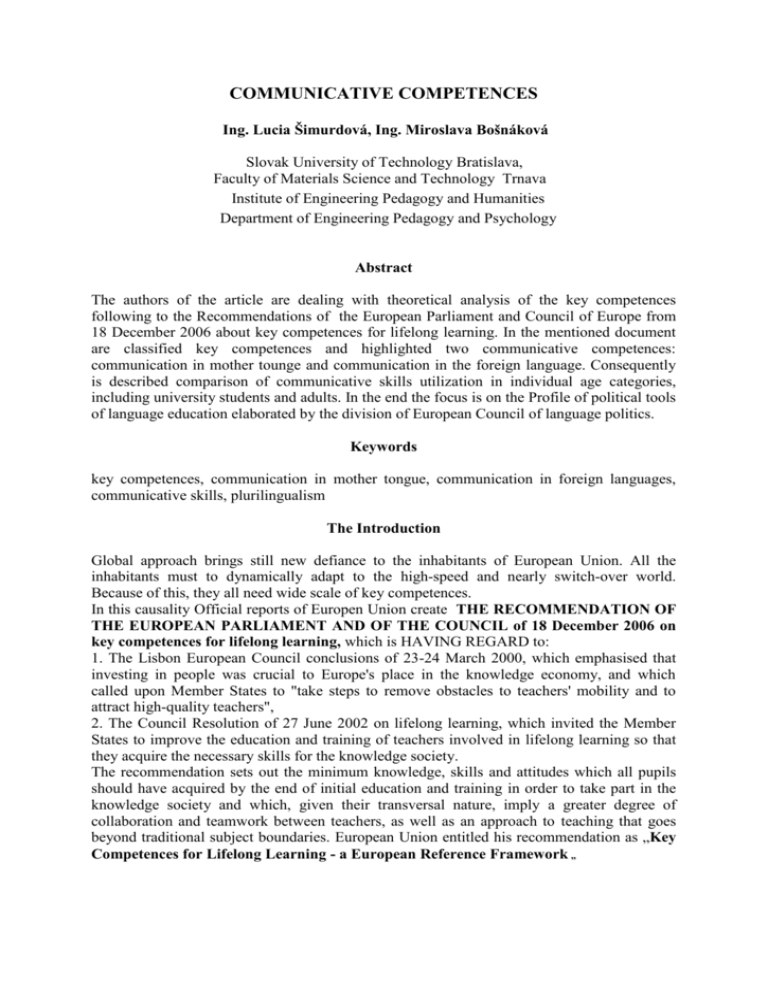
COMMUNICATIVE COMPETENCES Ing. Lucia Šimurdová, Ing. Miroslava Bošnáková Slovak University of Technology Bratislava, Faculty of Materials Science and Technology Trnava Institute of Engineering Pedagogy and Humanities Department of Engineering Pedagogy and Psychology Abstract The authors of the article are dealing with theoretical analysis of the key competences following to the Recommendations of the European Parliament and Council of Europe from 18 December 2006 about key competences for lifelong learning. In the mentioned document are classified key competences and highlighted two communicative competences: communication in mother tounge and communication in the foreign language. Consequently is described comparison of communicative skills utilization in individual age categories, including university students and adults. In the end the focus is on the Profile of political tools of language education elaborated by the division of European Council of language politics. Keywords key competences, communication in mother tongue, communication in foreign languages, communicative skills, plurilingualism The Introduction Global approach brings still new defiance to the inhabitants of European Union. All the inhabitants must to dynamically adapt to the high-speed and nearly switch-over world. Because of this, they all need wide scale of key competences. In this causality Official reports of Europen Union create THE RECOMMENDATION OF THE EUROPEAN PARLIAMENT AND OF THE COUNCIL of 18 December 2006 on key competences for lifelong learning, which is HAVING REGARD to: 1. The Lisbon European Council conclusions of 23-24 March 2000, which emphasised that investing in people was crucial to Europe's place in the knowledge economy, and which called upon Member States to "take steps to remove obstacles to teachers' mobility and to attract high-quality teachers", 2. The Council Resolution of 27 June 2002 on lifelong learning, which invited the Member States to improve the education and training of teachers involved in lifelong learning so that they acquire the necessary skills for the knowledge society. The recommendation sets out the minimum knowledge, skills and attitudes which all pupils should have acquired by the end of initial education and training in order to take part in the knowledge society and which, given their transversal nature, imply a greater degree of collaboration and teamwork between teachers, as well as an approach to teaching that goes beyond traditional subject boundaries. European Union entitled his recommendation as „Key Competences for Lifelong Learning - a European Reference Framework „ Key Competences for Lifelong Learning - A European Reference Framework This Framework sets out the eight key competences: 1. Communication in the mother tongue; 2. Communication in the foreign languages; 3. Mathematical competence and basic competences in science and technology; 4. Digital competence; 5. Learning to learn; 6. Interpersonal, intercultural and social competences and civic competence; 7. Entrepreneurship; and 8. Cultural expression. Competences are defined here as a combination of knowledge, skills and attitudes appropriate to the context. Key competences are those which all individuals need for personal fulfilment and development, active citizenship, social inclusion and employment. By the end of initial education and training young people should have developed the key competences to a level that equips them for adult life, and they should be further developed, maintained and updated as part of lifelong learning. Many of the competences overlap and interlock: aspects essential to one domain will support competence in another. Competence in the fundamental basic skills of language, literacy, numeracy and ICT is an essential foundation for learning, and learning to learn supports all learning activities. There are a number of themes that are applied throughout the Framework: critical thinking, creativity, initiative taking, problem solving, risk assessment, decision taking, and managing feelings constructively play a role in all eight key competences. Communication in the mother tongue Definition: Communication in the mother tongue is the ability to express and interpret thoughts, feelings and facts in both oral and written form (listening, speaking, reading and writing), and to interact linguistically in an appropriate way in the full range of societal and cultural contexts — education and training, work, home and leisure. Essential knowledge, skills and attitudes related to this competence Communication in the mother tongue requires an individual to have knowledge of basic vocabulary, functional grammar and the functions of language. It includes an awareness of the main types of verbal interaction, a range of literary and non-literary texts, the main features of different styles and registers of language, and the variability of language and communication in different contexts. Individuals should have the skills to communicate in oral and written forms in a variety of communicative situations and to monitor and adapt their own communication to the requirements of the situation. Competence also includes the abilities to write and read different types of texts, search, collect and process information, use aids, formulate and express one’s own arguments in a convincing way appropriate to the context. A positive attitude towards communication in the mother tongue involves a disposition to critical and constructive dialogue, an appreciation of aesthetic qualities and a willingness to strive for them, and an interest in interaction with others. Communication in foreign languages Definition: Communication in foreign languages broadly shares the main skill dimensions of communication in the mother tongue: it is based on the ability to understand, express and interpret thoughts, feelings and facts in both oral and written form (listening, speaking, reading and writing) in an appropriate range of societal contexts — work, home, leisure, education and training — according to one’s wants or needs. Communication in foreign languages also calls for skills such as mediation and intercultural understanding. An individual’s level of proficiency will vary between the four dimensions, different languages and according to their background, environment and needs/interests. Essential knowledge, skills and attitudes related to this competence Competence in additional or foreign languages requires knowledge of vocabulary and functional grammar and an awareness of the main types of verbal interaction and registers of language. Knowledge of societal conventions, and the cultural aspect and variability of languages is important. Essential skills consist of the ability to understand spoken messages, to initiate, sustain and conclude conversations and to read and understand texts appropriate to the individual’s needs. Individuals should also be able to use aids appropriately, and learn languages also informally as part of lifelong learning. A positive attitude involves the appreciation of cultural differences and diversity, and an interest and curiosity in languages and intercultural communication. Communicative skills Communicative skills are integrated skills, because they are all each other dissolved and complemented. According to K. Šebesta (1999, s. 61) communication is realising in accordance with teaching goals by acoustic and visual medium. Following this he classifies communicative skills: Table no 1Dividing of communicative skills Acoustic medium listening speaking Visual reading writing medium empirical skills productive skills . Correct learning to learn support all the educational movements. Average human remember (according to R.Hrmo, I.Turek,2003, s.71) circa: 10 % from reading, 20 % from listening, 30 % from visual form, 70 % from visual form and listening, 80 % from visual form,listening and speakig, 90 % from we practise themselves Child in stage of language vindicated start look like the listener. He/she listen and starts understand language earlier, then he/she can talk, read or write. Listening is the first communicative skill, which the child practises. It is the bases for all the skills and also for effective and cultural communication. Intensity of listening skills development belong to fundamental condition of school readiness. And adults stay listener throught their whole life. In the year 1926 P.T. Rankin with his colleagues from the Mitchigens´ University (according to R.J. Tierney, 1990, s.318) measure quantity of the time, which people spend by using diferent communicative skills during the day. He recognize, that around 70% people spend its watchful time by communication, 42% by listening, 32% by talking, 15% by reading and 11% by writing. In the year 2002 was realisated the similar survey (according to J. Palenčárová, K. Šebesta, 2006), which showed bigger share of listening like in front of years.The results from the research sample, which comprise 178 participants from diferent profession and whit diferent ages (18 - 94 year) was showed, that 50% people spend its time by listening, 25% by speaking, 15% by reading and 10% by writing. So we can say that adults spend more time by listening, then by using other communicative skills. It is Interesting, that this results point to the upthrow of the time, which people spend by speaking in compare with results from the year 1926. 60% 50% 50% 42% 40% 32% 30% 25% 15% 15% 20% 10% 11% 10% 0% Listening 1926 Speaking Reading Writing 2002 Figure no.1:Exploitation of communicative skills byadults during the day In the year 1981 Barker with his collective (according to Z.Vybíral, 2000, s.101) published results of his survey, which showed, that university students in the time, when they are communicating, use 53% by listening, 16% by speaking, 17% by reading and 14% by writing. These investigations were about six years later confirm. The survey from the year 2002 (according to J.Palenčarová, K.Šebesta, 2006), with participants from various types of Slovak university students (together 574 students), brought following results. Average17-hours running day (from 600 to 2300 hours) consists of 45% listening, 20% speaking, 18% reading and 17% writing. The time of listening in comparison with results of survey from the year 1981 decrease, but it still stays the most used communication ability. Positive is that, speaking has raising share. Raising of quantity time, which students use to writing and reading, is probably caused by actual development of electronic media, computers and mobile communication (popular SMS news). 60% 50% 40% 30% 20% 10% 0% 53% 45% 16% Listening 1981 20% Speaking 17% 18% 14% 17% Reading Writing 2002 Figure no.2: Exploitation of communicative skills by university students during the day According to survey (J.Palenčárová, K. Šebesta, 2006) we can formulate the proportion of four basic communicative skills(listening,speaking, reading and writing) 8:4:3:2. The graph number 3 shows the relative time, which uses individual age rank to the various communicative activities. 50 40 30 20 10 0 Listening Speaking Reading Writing adult university student 1.level elementary school 2.level elementary school and secondary school Figure no.3: Proportion of communicative skills Profile of political tools of language education Language politics division of European Council CE offers all his state members co-operation and own collective experience and forms from them possibility to analyze and revaluate their orientation in teaching languages. This division receives for state members possibility to better score their own language political tools in a dialogue with expert from CE with reference to aditional development of language politics in several countries. Working-out of language educate profile is not evaluation, but it is a process of reflection between representatives of citizens society and experts from CE are middle fingers in dialogue, which they carry on. This convention is diferent from other international conventions about language, because it deals with languages in relation with teaching in the frame and also out of the frame of national institutions. It study teaching of foreign languages, also national, public languages and regional and minorities languages. Magistracy of commision of control training and education CE reconciles request of working-out the profile for the Slovak Republic. The Slovak Republic worked-out and transfer the report in January 2005. It contains analysis element of the present stage, which go out from Administration of The Slovak Republic and from perspective sketching of politics language educational development in the Slovak Republic for purpose of plurilingualism support and develop. Conclusion Communicative competence covers wide semantic field. It is bound up with communication process and it reckons with all relevant objective and subjective components of the communication situation. Communicative competence also implies that knowledges, which select and use language and above-language facilities in diferent communication situation. In communicative competences are included too further knowledges, which help talker to communicate language and sociable abreast. It is not only language, but also sociable problem. My work is focused to this wide theme and it is aimed as theoretical survey of solving problem. It consists of knowledge systematization and it is instrumental to starting point for processing of language curiculum and also for possible needs analysis and it is a base for working-out list of questions. In my work I point out, that key competences produce unthinkable component of lifelong learning. I suggest solving problem in the future apply in frame on-comming project VEGA dealing with key language competences. References: [1] HRMO, R., TUREK, I. Kľúčové kompetencie I. Bratislava: STU, 2003. 178 s. ISBN 80227-1881-5 [2] ODPORÚČANIE EURÓPSKEHO PARLAMENTU A RADY z 18. decembra 2006 o kľúčových kompetenciách pre celoživotné vzdelávanie (2006/962/ES) [3] PROFIL VYKONÁVACÍCH POLITICKÝCH NÁSTROJOV JAZYKOVÉHO VZDELÁVANIA, Divízia jazykovej politiky RADY EURÓPY, Ministerstvo školstva Slovenskej republiky, 2007 [4] PALENČÁROVÁ, J., ŠEBESTA, K. Aktivní naslouchaní. Praha: Portál, 2006 [5] ŠEBESTA, K.: Od jazyka ke komunikaci. Praha, Univerzita Karlova – Karolinum 1999. [6] TIERNEY, R. J. – READENCE, J. E. – DISHNER, E. K.: Reading strategies and practices. Boston, Alin and Bacon 1990. [7] VYBÍRAL, Z.: Psychologie lidské komunikace. Praha, Portál 2000.
